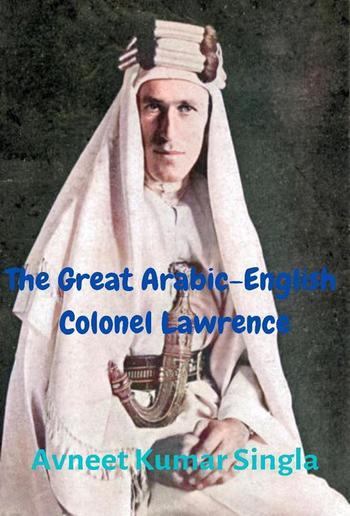
Avneet Kumar Singla - The Great Arabic-English Colonel Lawrence
The Great Arabic-English Colonel Lawrence
Avneet Kumar Singla
Descripción
This book tries to describe a great life story and experiences of T.E. Lawrence. This is a large Non-fiction biographical book consists of 122 chapters divides in 10 parts and consists of 260000 words (approximately).
Colonel Thomas Edward Lawrence, CB, DSO (16 August 1888-19 May 1935), a British archaeologist, army officer, diplomat and writer, became known for his role in the Arab Revolt (1916-1918) and the Sinai and Palestine campaign (1915-1918) against the Ottoman Empire during World War I. The breadth and variety of his activities and associations, and his ability to vividly describe them in writing, earned him international fame as Lawrence of Arabia, a title used in 1962 for the film based on his wartime activities.
He was born in August 1888, the son of Sarah Junner (1861 - 1959), a governess, and Thomas Chapman (1846 - 1919), an Anglo-Irish nobleman. Chapman left his wife and family in Ireland to live with Junner. Chapman and Junner called themselves Mr and Mrs Lawrence, with the surname of Sarah's likely Father; their mother had been employed as a servant for a Lawrence family when she became pregnant with Sarah. In 1896 the Lawrences moved to Oxford, where Thomas attended high school and studied history at Jesus College, Oxford from 1907 to 1910. Between 1910 and 1914, he worked as an archaeologist for the British Museum, mainly in Carchemish in Ottoman Syria.
Shortly after the outbreak of the war in 1914, he volunteered for the British Army and was stationed in Egypt in the intelligence unit Arab Bureau, founded in 1916. In 1916 he travelled with intelligence missions to Mesopotamia and Arabia and quickly participated in the Arab Revolt as a link to the Arab forces, along with other British officers who supported the war of independence of the Arab kingdom of Hejaz against its former overlord, the Ottoman Empire. He worked closely with Emir Faisal, a leader of the revolt, and sometimes participated as a leader in military actions against the Ottoman forces that culminated in the capture of Damascus in October 1918.
Lawrence was appointed a companion of the order of the bath on 7 August 1917, a companion of the Distinguished Service Order on 10 May 1918, a knight of the legion of Honour (France) on 30 May 1916 and a Croix de guerre (France) on 16 April 1918.
A bronze bust of Lawrence by Eric Kennington was erected in the Crypt of St. Paul's Cathedral in London on January 22, 1936, next to the graves of the greatest British military leaders. A recumbent stone effigy of Kennington was installed in 1939 in St Martin's Church, Wareham, Dorset.
An English Heritage Blue Plaque Marks Lawrence's childhood home at 2 Polstead Road, Oxford, and another appears on his London home at 14 Barton Street, Westminster. Lawrence appears on the album cover of Sgt. Pepper's Lonely Hearts Club Band of the Beatles. In 2002, after a British vote, Lawrence was voted 53rd on the BBC's list of the 100 Greatest Britons.

